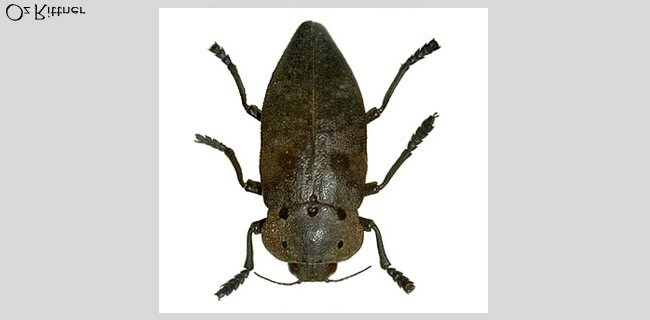Vierme cabezudu
(Capnodis tenebricosa)

Description
Capnodis tenebrionis is a species of coleoptera of the Buprestidae family of opaque black color, it spreads through many parts and with particular frequency in more temperate regions, constituting a pest for various fruit trees. It is commonly known by the name of vierme cabezudu, a name that comes from the abuitáu prothorax that your canesbes have less and that they make look like a vierme (although you don't see it) with a big head. They are the canes of this insect that cause the greatest damage to crops, since they develop inside the roots of various fruit species, feeding on wood and in case of strong attacks they kill the tree and can totally ruin a seedling The adults feed on the fires of the trees, frequently eating their petioles, so that the fire falls to the ground and it is easy to detect the presence of the insect by looking at the ground and seeing where the fresh fires fall. It attacks various species of wild and cultivated rosaceae. A symptom of the attack on apricot trees may be the production of gum and the fall and ensugau of the firewood. Other species that are also attacked are the almond tree, pescal, cirolar, etc. Damage is usually favored by intense dry periods. The difficulty of the fight is the difficult access of the agrochemicals to the roots of the root canal. From the biological study, repair the two most important periods of the life of the adult that allows to control its population more effectively: emergence as an adult before the wintering period and exit from wintering before egg laying. The extension is increasingly greater, favored by the increase in temperatures due to climate change, agricultural practices and especially due to dryness. For this last fact, this pest can especially affect dryland cultivation. In recent years, some agronomic factors seem to increase the pest population, such as the choice of rootstocks with more superficial root development, which increases the survival of eggs and canesbes, and the pressure of the xube pest, causing greater population pressure for the rest of the trees. Anguaño is causing significant damage to fruit trees in general and to almond trees in particular. In addition to the previously mentioned crops, it also occasionally attacks pear trees, pumares and figales, nozal, cadapanu and ablanar. The damages produced both in adulthood due to the destruction of yems, biltos and bellows, as well as canesba due to the destruction of the root system.
Taxonomic tree:







